
School administrators spend countless hours trying to keep their facilities in the best possible shape through routine maintenance and regular inspections, and other preventative tasks. While these efforts detract from the role they were hired to do, the upkeep is vitally important. Students and the educational community-at-large benefit from positive surroundings, particularly student health and learning. Schools have a responsibility to do everything they can to promote a healthy learning environment, and proactive facilities management is an integral component.
The well-being of students and staff is a top priority. When facilities undermine this, performance suffers. Many parts of the educational process rely on comfortable, safe settings. If the temperature is too hot or cold, for example, or the lighting is too dark or too bright, students may become frustrated and struggle to focus. Teachers may have a difficult time conducting lessons and get frustrated.
Optimizing school facilities should be the cornerstone of every district’s mission to ensure students, teachers, and staff perform at their best and generate positive attitudes about your district overall.
Impact of School Facilities on Student Health
Researchers have found that the quality of school facilities impacts student academic performance and learning. Students focus better when they’re comfortable, are more likely to attend classes, and may be less likely to become ill. These qualities all come from classrooms that have proper ventilation, are well-lit, and maintain efficient cleaning schedules. Students who aren’t distracted or uncomfortable due to environmental factors are students who can remain attentive and better retain information.
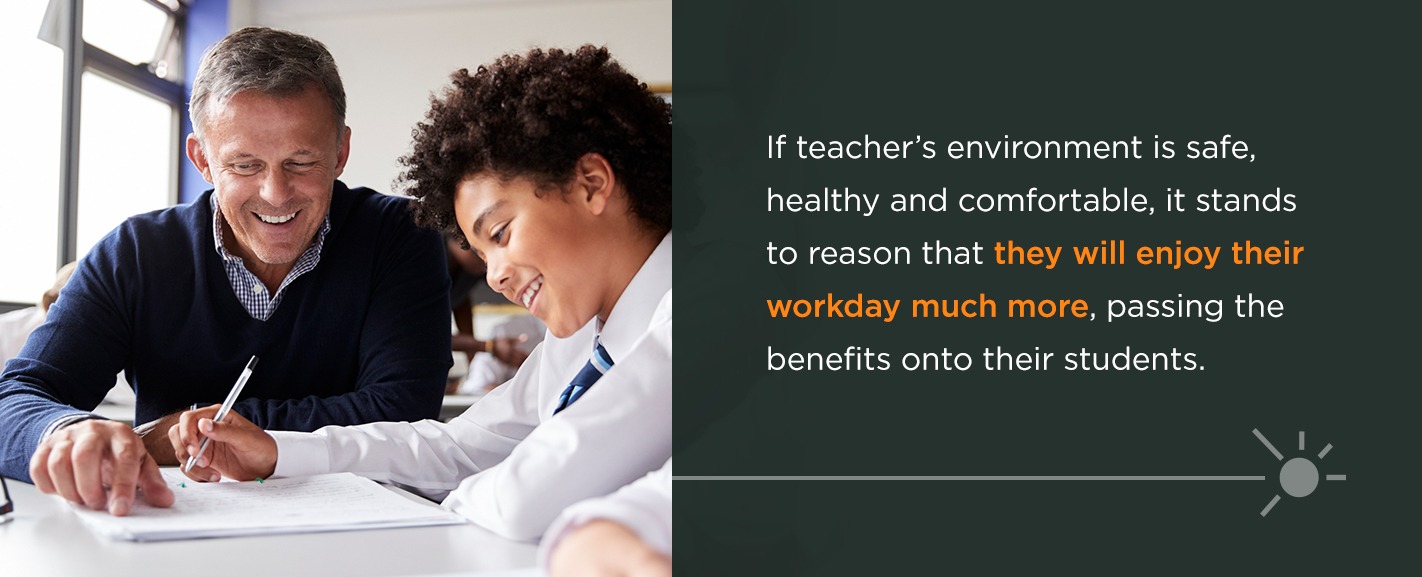
This same idea applies to teachers. A teacher who doesn’t have environmental distractions can concentrate on students. If the work environment is safe, healthy, and comfortable, it stands to reason that teachers will enjoy their workday much more, passing the benefits on to their students. Favorable school facility conditions are likely to improve educational outcomes since veteran teachers may be less likely to leave, and qualified teachers may be more easily recruited.
A better learning environment isn’t the only benefit of adequate facilities. The improvement in the physical health of the students and teachers is also substantial.
A student with asthma may struggle to pay attention in a room with low air quality. Students who are more susceptible to certain illnesses and bacteria may be more likely to get sick in a classroom that doesn’t routinely sanitize surfaces. These factors can prevent a student from showing up to class, lowering a district’s attendance and performance ratings. Likewise, an unhealthy environment can lead to more sick days for teachers.
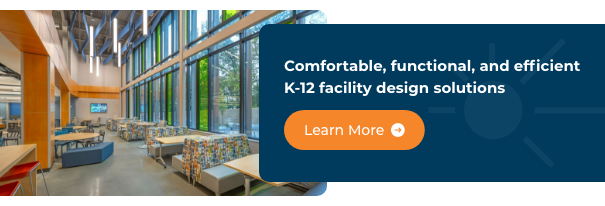
So how can these scenarios be prevented? Improving maintenance procedures and reviewing the performance of your ventilation, lighting, and custodial services are a few strategies. Whatever you do, it is crucial to remember the link between your school facilities and student health.
Four Ways That School Facilities Impact Student Health and Achievement
Now that we’ve established the importance of the physical environment in education, let’s consider how they influence each other and how facility quality impacts students’ academic performance and health.
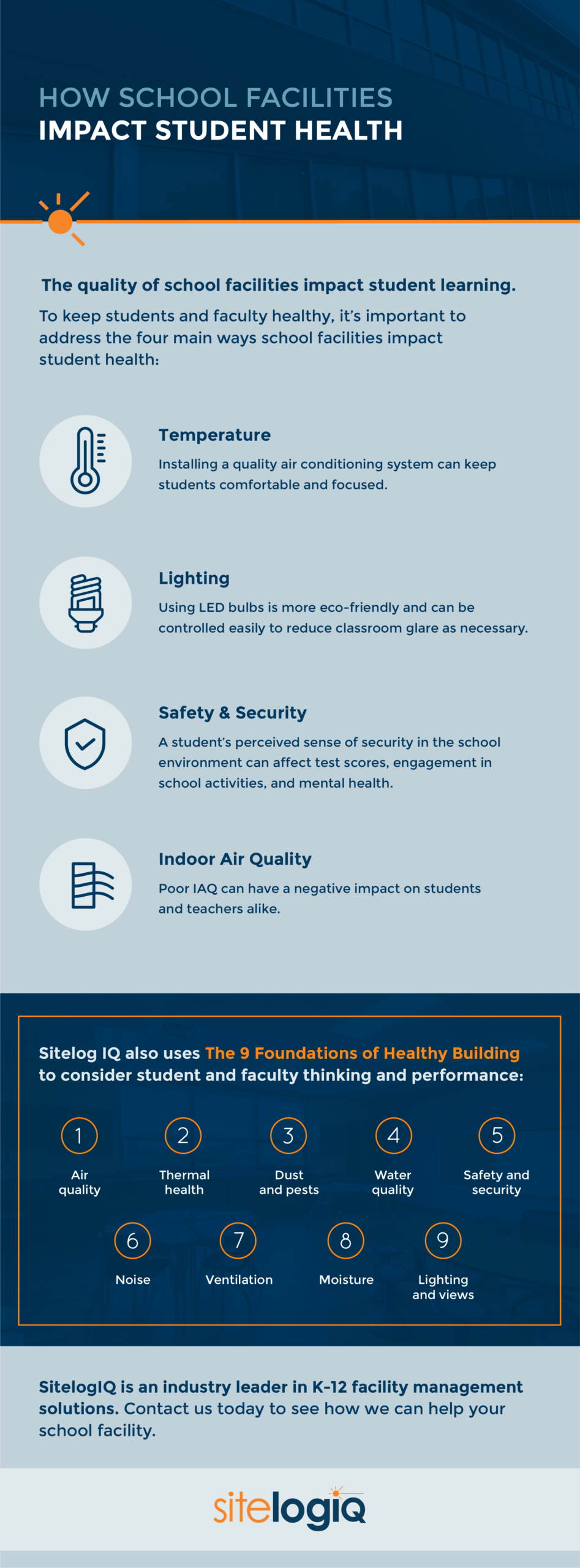
1. Temperature
Many people consider air conditioning to be a necessity, but for many schools around the country, this isn’t the case. As average temperatures climb, students in the U.S. go to class expecting to sweat in high heat, rather than wonder what they will be learning in class. Even schools that spend most of the year with cold weather can face excessively high temperatures in late spring and summer. When it comes to education, air conditioning can be vital to the continued learning and performance of students.
Anecdotally, many teachers and students are familiar with the struggle of when it gets too hot to learn. Teachers say that children may fight to pay attention, become less compliant, and don’t want to do anything in the sweltering heat. A study conducted by researchers at the Harvard Kennedy School tells us that for each increase in one degree over 90 F, students lose nearly 1% of the year’s learning. Temperatures over 100 F have an effect that is up to 50% larger.
While a district’s wealth influences its likelihood of having air conditioning, all around the country, in both wealthy and non-wealthy areas, you can find schools lacking in air conditioning. For example:
- In Detroit, just one in three schools has air conditioning.
- In New York City, a quarter of classrooms lack air conditioning.
- Hawaii, where temperatures year-round are often in the upper 80s, only has air conditioning in 40% of classrooms.
A well-functioning air conditioning system can keep almost all of these heat-related problems at bay. Unfortunately, many schools that do have air conditioning don’t have efficient systems and may still deal with inconsistent or nonfunctioning heating and cooling. About 30% of public schools consider their air conditioning and heating system to be fair or poor.
Installing a quality air conditioning system and keeping it maintained can help mitigate comfort issues. Students can focus better, improve their academic performances, and end the school day with (quite literally) cooler heads.
2. Lighting
Lighting has changed quite a bit since the construction of many 20th-century schools. Until the ’50s, natural light was the dominant approach to keeping classrooms bright. Large windows were used to illuminate the space, but as electricity became cheaper and easier to obtain, natural daylight was pushed aside.
Natural light has a variety of positive influences on learning and productivity due to its psychological and physiological effects. It results in higher levels of vitamin D and energy while improving sleep and reducing the effects of seasonal affective disorder (SAD). Designing for natural daylight is an excellent way to promote alertness and productivity in the classroom.
But daylight isn’t without its disadvantages. It can’t be the only light source, of course, as inclement weather, early winter darkness, and nighttime events all require a secondary source of lighting. Daylight can also be frustrating in some classrooms, especially those using substantial amounts of technology, due to the glare large windows create. Using low-glare designs and adjustable lights and adapting to the amount of daylight present can all combat the adverse aspects of natural lighting.
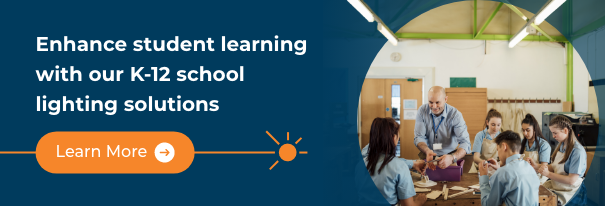
Energy-saving lighting is an area where many schools can save money. Replacing old, headache-inducing lights with LED bulbs can reduce energy costs, decrease maintenance needs, and even improve safety due to their reduced heat output. These eco-friendly lights can also pair with advanced lighting controls.
Connecting your lights to the Internet of Things (IoT) can automate the task of keeping your building bright. You can reduce consumption by turning off lights in spaces that are not in use or install lights that respond to the amount of natural daylight present, reducing or increasing the brightness as necessary. Many of these lighting solutions can also help make your facility more sustainable.
3. Surface Hygiene
Basic cleanliness is a fundamental aspect of any environment, but especially one where the health and safety of children is a priority. The recent pandemic has spotlighted attention to the importance of cleanliness and pathogen mitigation in school facilities. Schools can be full of germs, and many children don’t know how to protect themselves against viruses and bacteria. Millions of children miss school due to illnesses that could have been lessened with proper sanitation.
For example, one study of athletic training rooms in schools found staphylococcus aureus (MRSA) and vancomycin-resistant enterococcus (VRE) on 24% of surfaces and influenza on 25% of surfaces. After new hygiene protocols were put in place, these pathogens were eliminated entirely.
Encouraging basic cleaning and hygienic practices can go a long way in cultivating a clean building. Make sure teachers do their part to stay safe and show their students how to, as well. Coughing into the elbow, using tissues, and following other hygienic practices can be especially helpful during flu season to reduce absences and improve student achievement. Teachers can disinfect commonly touched fixtures like doorknobs, computer mice, and light switches frequently.
Custodial staff are also crucial in this area. Appropriate planning can ensure that surfaces are regularly cleaned and sanitized. Integrating a work order system with facility management software may help to stay on top of cleaning tasks. In addition to routine cleaning tasks, you can employ both short-term and long-term pathogen mitigation solutions to make your school a safer, healthier space for students and staff.
The benefits of a clean school go beyond hygiene. An orderly, clean school conveys a message of sincerity and dedication. Students see that their school holds high standards, and teachers know that they work in a place that takes education seriously. These positive connotations can help improve the learning environment, and they give visitors an excellent impression of your commitment to the educational atmosphere.
4. Indoor Air Quality
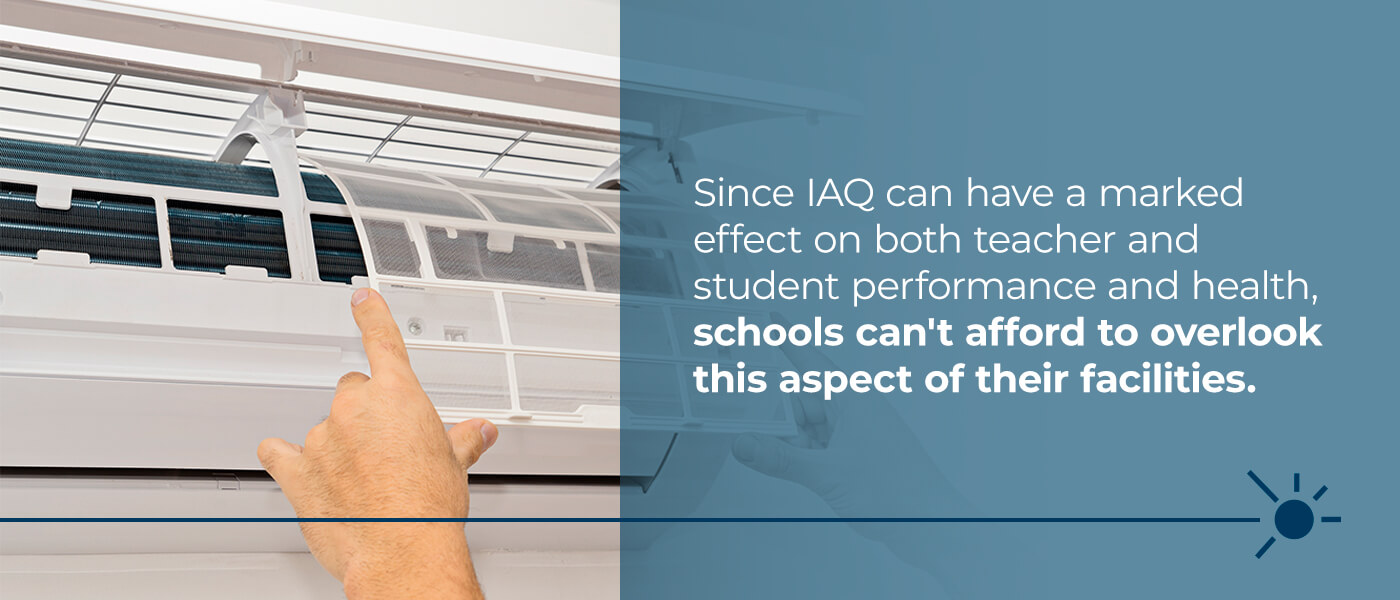
Indoor air quality (IAQ) is another factor to consider. IAQ has a pronounced effect on children compared to adults, making IAQ in schools a matter of special importance. The Environmental Protection Agency (EPA) highlights this importance, specifically pointing to the following factors, which all influence a school’s IAQ:
- Airborne pollutants
- Circulation of outdoor air
- Temperature and relative humidity (RH)
Poor IAQ can have an immediate impact on students and teachers, causing allergic reactions or asthma attacks in severe cases. IAQ impacts comfort levels as well, either promoting or detracting from positive attitudes and concentration. No one wants to feel trapped in a stuffy room.
In addition to these immediately felt consequences, exposure to pollutants like dust, mold, and mildew can be detrimental to health long-term. One study even found that teachers with prolonged exposure to relative humidity levels that were either too high or too low were more likely to experience respiratory problems. Bacteria, viruses, allergens, and irritants may continue to thrive in a room despite efforts to sanitize surfaces because the RH is contributing to the problem.
Every school should have their IAQ assessed to determine effective improvement measures. This includes auditing the HVAC system and identifying any potential pollutants that need to be filtered. A humidifier or dehumidifier may help maintain comfortable and healthy RH levels. Since IAQ can have a marked effect on both teacher and student performance and health, schools can’t afford to overlook this aspect of their facilities.
Updated Facilities and the Learning Environment
One transformational component in education is the addition of technology. Though technologies like SMART Boards have been around since the ’90s, policies of one-to-one device usage and developments in instructional techniques have changed the landscape of the traditional classroom. The classic layout with rows of desks facing a teacher and a whiteboard is less common. As pedagogy has changed, so have desk layouts and innovative seating options.
As teaching methods have changed, so must our approach to improving school facilities. Right now, that means flexibility, access to technology, and interactive learning.
Some of the challenges of 21st-century learning involve providing sufficient and accessible locations for charging educational devices, such as laptops, across an entire classroom and creating optimal lighting conditions so students can easily see the screen. The modern learning landscape also offers unique opportunities. Smart lighting and thermostats can help you automate your utilities to be more energy-efficient and comfortable for teachers and students.
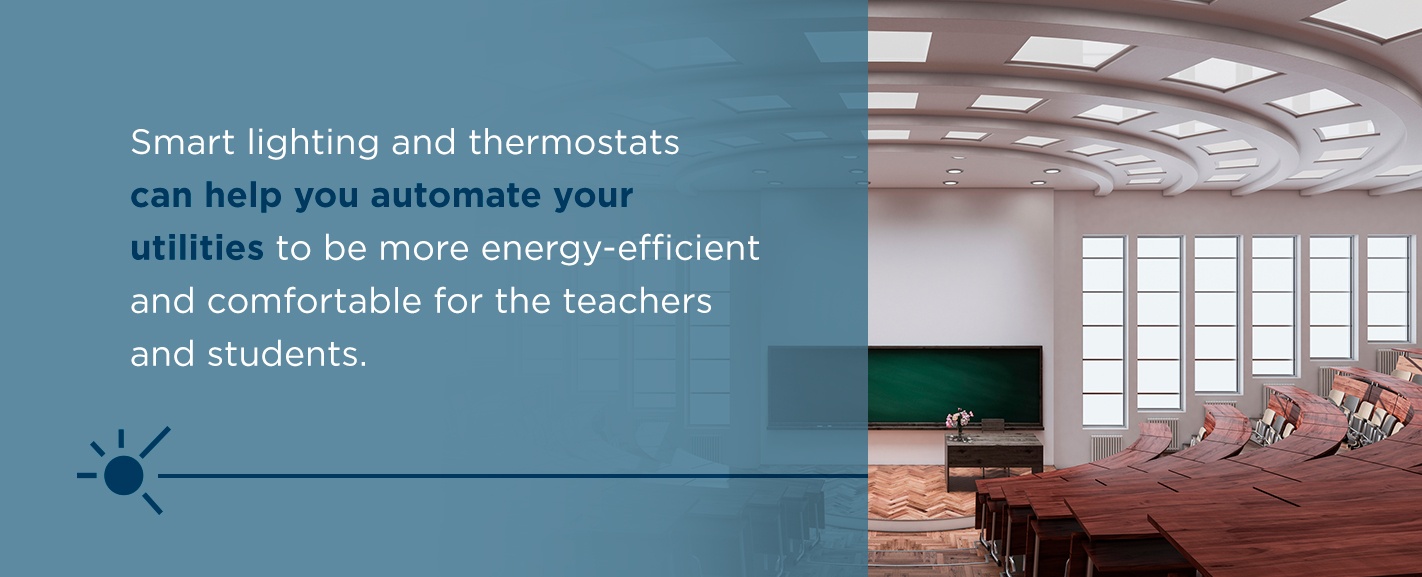
The benefits of improving school facilities are widespread. From adding glare-free lighting in a classroom to free-flowing air conditioning in the gymnasium, you can help your students learn better at all points throughout the day. Changes in a student’s environment influence several different spheres of the educational world.
Facility management systems impact the quality of the environment, which affects the performance of students, teachers, and staff. Performance shapes attitudes. Attitudes, in turn, affect their teaching and learning behaviors, which impact student achievement and educational results. In the end, all of this determines future outcomes of individuals and society as a whole.
The system is intertwined, and the resulting academic performance can even influence a school’s future access to resources and benefits. Even something that seems to be relatively simple, like the choice of lighting in a classroom, can have wide-reaching effects. This demonstrates the importance of school facilities in modern education.
Changes to your school’s facilities can deliver improvements across various areas of education. Students can focus better, teachers enjoy their work more, and everyone develops a better attitude toward the facility they spend time in every weekday.
With limited budgets, many districts are hesitant to spend money on infrastructure like lights and HVAC systems, but the improvements speak for themselves. A general sense of well-being does wonders for the atmosphere in a school. Unfortunately, more than half of U.S. public schools in 2012 had inadequate structural facilities. Schools that serve students of lower-income families and large populations of people of color are particularly at a disadvantage.
An investment in facilities is an investment in student education. Better-performing students may net you more resources, and you could save money through energy-saving upgrades, making your district eco-friendly, as well.
A school’s facilities should be representative of its staff, values, and philosophies. If school leaders believe student learning is a top priority, they cannot underestimate the value of the overall physical environment. Often, educators interpret this concept as desk layout or classroom decorations, but aspects they may take for granted, like air quality and temperature, are just as essential. This atmosphere is a significant player in determining student success — and SitelogIQ can help you cultivate it.
A Custom Approach to Facilities Management
At SitelogIQ, we understand that your district is unique. A one-size-fits-all approach doesn’t work for facilities management, which is why we take the time to comprehensively assess the needs of your facilities, district, and community. With this information, we will develop a plan for how to improve your school’s facilities and the learning space for your students.
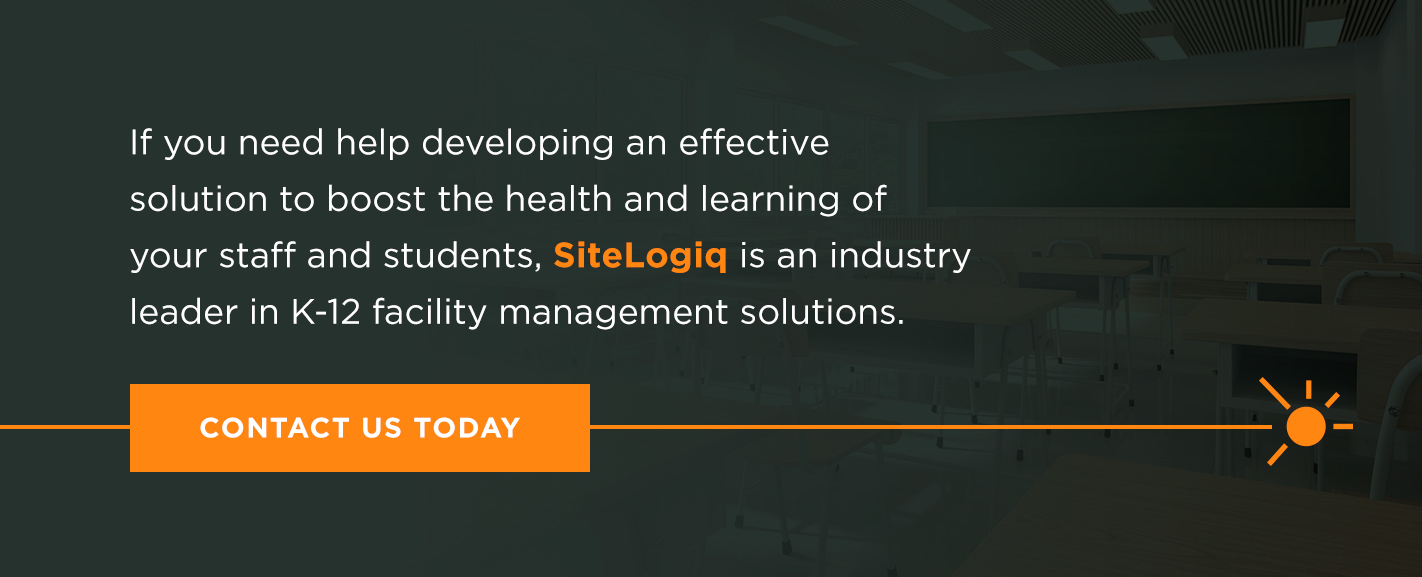
We can address a variety of building management needs, including lighting, HVAC, and design. Our team of professionals can tear down deteriorating architecture, renovate within an existing footprint, or upgrade systems and fixtures as part of a turnkey solution to help your students enjoy a safe and comfortable learning environment.
If you need help developing an effective solution to boost the health and learning of your staff and students, SitelogIQ is an industry leader in K-12 facility management solutions. Contact us today to learn more about our energy consultation services and how we can elevate your students’ education to the next level.


